Class 1 Exam > Class 1 Notes > EVS for Class 1 > Parts of Plants: Plants Around Us
Parts of Plants: Plants Around Us | EVS for Class 1 PDF Download

The document Parts of Plants: Plants Around Us | EVS for Class 1 is a part of the Class 1 Course EVS for Class 1.
All you need of Class 1 at this link: Class 1
|
33 videos|215 docs|44 tests
|
FAQs on Parts of Plants: Plants Around Us - EVS for Class 1
| 1. What are the main parts of a plant? |  |
Ans. The main parts of a plant are the roots, stem, leaves, flowers, and fruits. Each part has a specific function that helps the plant grow and survive. Roots anchor the plant and absorb water and nutrients from the soil. The stem supports the plant and transports nutrients and water between the roots and leaves. Leaves are where photosynthesis occurs, allowing the plant to make its food. Flowers are important for reproduction, and fruits contain seeds for growing new plants.
| 2. Why are roots important for plants? |  |
Ans. Roots are crucial for plants because they anchor the plant in the ground, preventing it from being uprooted by wind or rain. Additionally, roots absorb water and essential nutrients from the soil, which are necessary for the plant's growth and development. Without healthy roots, a plant cannot thrive.
| 3. How do leaves help in the process of photosynthesis? |  |
Ans. Leaves play a vital role in photosynthesis by capturing sunlight and using it to convert carbon dioxide and water into food for the plant. They contain a green pigment called chlorophyll, which helps in absorbing sunlight. This process not only provides energy for the plant but also produces oxygen, which is released into the atmosphere.
| 4. What is the role of flowers in plants? |  |
Ans. Flowers are the reproductive parts of plants. They contain male and female organs that facilitate the process of pollination, which is essential for the formation of seeds. Flowers attract pollinators like bees and butterflies, helping to ensure that plants can reproduce and continue their species.
| 5. How do fruits help in the life cycle of a plant? |  |
Ans. Fruits are important because they protect the seeds and help in their dispersal. Once the seeds are mature, the fruit may fall to the ground or be eaten by animals, which then spread the seeds to new locations. This process helps plants grow in new areas, ensuring the continuation of the plant species.
Related Searches





















